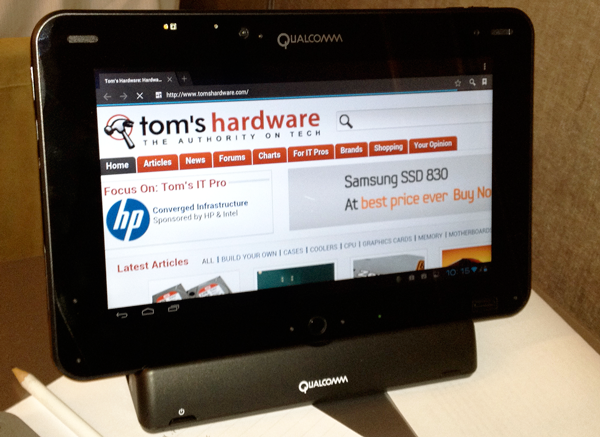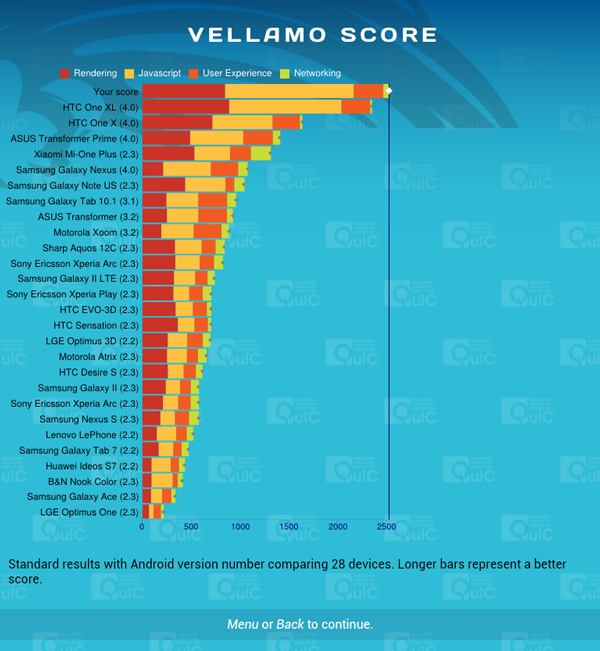Qualcomm's S4 Pro (Adreno 320): Big GPU Performance
Qualcomm invited a few members of the press for a benchmarking workshop. More than anything else, the discussion was about how to evaluate tablet/smartphone hardware in a manner that best reflects real-world use. We won't bore you with the details, but we have some internal tests that we're cooking up on that front.
More importantly, Qualcomm used the event as an opportunity to preview the S4 Pro. More specifically, the APQ8064, which you'll likely see in tablets later this year. This SoC is the brother of the MSM version you'll see in smartphones, only lacking the Gobi modem for cellular connectivity. What we're playing with isn't part of any final product. As our friends at SlashGear reported, Qualcomm is specifically highlighting its MDP (Mobile Development Platform), which "contains the same 10.1-inch display as we’ve seen on previous developer devices, as well as multiple ports, fingerprint scanners, 13 megapixel cameras and more. It even has 7 microphones on this thing. Running on Android 4.0.4 Ice Cream Sandwich, their new quad-core processor, 2GB of RAM — once again those four processing cores."
The kit costs $1299 through BSQUARE, which seems outrageous, but again this is a platform meant for developers. Tablets featuring the S4 Pro should be competitively priced against those sporting Tegra 3 hardware. However, the MDP is important to us because it gives us a first glimpse of what to expect performance wise.
Overall, we can't help but be impressed. Graphics performance sees a huge boost, which is encouraging. We're told this GPU has been three years in the making, and it's the first silicon Qualcomm designed from the ground up. Past GPUs like the Adreno 220 (found in the LePad II and TouchPad) was based on IP gained from the acquisition of AMD's Imageon IP.
| GLBenchmark 2.1*native resolution | iPad 2 | iPad 3 | Transformer Prime | Qualcomm Dev Tablet |
|---|---|---|---|---|
| GPU | PowerVR SGX543MP2 | PowerVR SGX543MP4 | Tegra 3 (ULP GeForce) | Adreno 320 |
| Egypt Standard* | 6661 frames (59 FPS) | 6709 frames (59 FPS) | 5388 frames (48 FPS) | 6748 frames (50 FPS) |
| Egypt Fixed Time Step* | 47.598 s (59 FPS) | 47.261 s (60 FPS) | 69.055 s (41 FPS) | 47.079 s (60 FPS) |
| Egypt Off Screen (720p) | 10 146 frames (90 FPS) | 15 663 frames (139 FPS) | 6496 frames (58 FPS) | 11 348 frames (100 FPS) |
| Pro Standard* | 2962 frames (59 FPS) | 2975 frames (60 FPS) | 2726 frames (54 FPS) | 3002 frames (60 FPS) |
| Pro Fixed Time Step* | 20.868 s (60 FPS) | 20.857 s (60 FPS) | 24.189 s (52 FPS) | 20.828 sec (60 FPS) |
| Pro Off Screen (720p) | 7352 frames (147 FPS) | 12546 frames (251 FPS) | 3717 frames (74 FPS) | 6741 frames (135 FPS) |
| Fill Rate | 998.2 Mtexels/sec | 1964.7 Mtextels/sec | 415.3 Mtexels/sec | 737.8 Mtexels/sec |
If we compare performance with GLBenchmark, it's clear that Qualcomm has something really eye opening here. In the offscreen tests, specifically, we're looking at almost 2x the performance of anything Tegra 3-based. We've seen an unreleased version of GLBenchmark that gives the S4 Pro a three-fold advantage over Tegra 3. If you're about to make a smartphone upgrade or new tablet purchase, what we've seen today provides a good case to hold off for a few months. Qualcomm tells us that we're should see S4 Pro devices later this year, just prior to Christmas. Of course, it's still interesting to point out that the A5X's PowerVR SGX543MP4 continues to hold a commanding lead as far as raw GPU performance goes. However, if you're dealing with Android, the S4 Pro appears to be the new "King of the Hill."
Unfortunately, Qualcomm's performance means very little unless it can get developers onboard. Nvidia's been doing a great job engaging developers, and it's something that Qualcomm needs to play catch up on. Tegra 3 continues to be attractive to the mobile gamer, because the platform has a slew of exclusive games, some of which include special render paths that take 3D gaming to the next level. For example, we don't get those enhanced water effects in Riptide GP as we do on the Transformer Prime or Transformer Pad (TF300T). There really isn't a mirror game that Qualcomm can use to tout the benefits of the Adreno 320, which the company badly needs.
However, to enable great software, you need great hardware. That's just how developers think, which is why Qualcomm has a great opportunity here to cast itself in a new light. The company has always done a great job showing how it can balance performance and power. Nvidia meanwhile has been hammering away at how important the former is if you're willing to give up a little of the latter. The S4 Pro changes the dynamic a bit. As Vellamo shows, CPU performance looks every bit impressive as GPU, and unlike Nvidia, Qualcomm has the benefit of leveraging low-power silicon. In principle, this gives Qualcomm the benefit of high performance without sacrificing any of the power consumption characteristics that Tegra IP sometimes falters from. The question now becomes, "Can Qualcomm help developers take advantage of all this horsepower?" That remains to be seen. Admittedly, we're willing to settle for a slightly slower (or less impressive smartphone) if there are more apps optimized for the hardware -- but the hardware looks good. Now we're waiting to see what Qualcomm can help deliver on the software side.
Get Tom's Hardware's best news and in-depth reviews, straight to your inbox.
-
killabanks still not up to par with a quad SGX543 but definitely a step in the right directionReply -
aznshinobi Not sure if it is the Adreno 325 but I'm pretty sure they expected/predicted that the Adreno 3xx would perform at console level graphics.Reply -
Belardo Blah blah blah... yawn.Reply
Am I reading this wrong? This is supposed to be exciting and such, because Tegra3 and Q are making more powerful GPUs, right? The Tergra3 is quite new and the new Q Adreno 320 isn't even out yet... but in the chart included above, both of these are losing out to the 5+ month old iPad3 and 1.5year old iPad2. Are these guys competing with the iPad1? You can bet in about 7~8 months the iPad4 will be on the market... -
They don't need to compete with any ipad, because people don't make the 'android / IOs' decision based on performance. For the most part if someone's buying a tablet they already know whether they want an iPad or an android tablet. When they decide to buy an Android tablet, then the performance comes into consideration.. so Qualcomm & Nvidia are only really competing with each other. Now, if lots of games came out that were multiplatform and ran noticeably better on the iPad AND consumers were aware that this was down to the GPU performance, we might start to see makers of android hardware up their game.Reply
-
Verrin I think it's pretty shameful and embarrassing that there's people on here making judgement on hardware based on SYNTHETIC benchmarks IN DIFFERENT ENVIRONMENTS. You can't get much worse when it comes to comparing apples to oranges, people.Reply -
nebun from the looks of things the "PowerVR SGX543MP4" is actually more powerful....take a look at the number on the bottom...now apple needs to work on the code a little more...this is the same problem AMD has...their graphics cards are powerful but the code suxReply -
cagi Why only Apple and Sony (PS Vita) uses PowerVR 543MP4? There are some Android devices with SoC from Samsung and TI that uses PowerVR 540 or 530 but now no one uses 543 instead of mali400?Reply -
eddieroolz Am I missing something here? It looks like the iPad3 demolishes the S4 Pro in most respects...Reply -
amdwilliam1985 chromonoidI love how it gets destroyed by the iPad 3Reply
I love how my $200 Nexus 7 can run smoother than your $500 iPad. haha, saving those $300 and putting them towards my 30 years mortgage ;)


